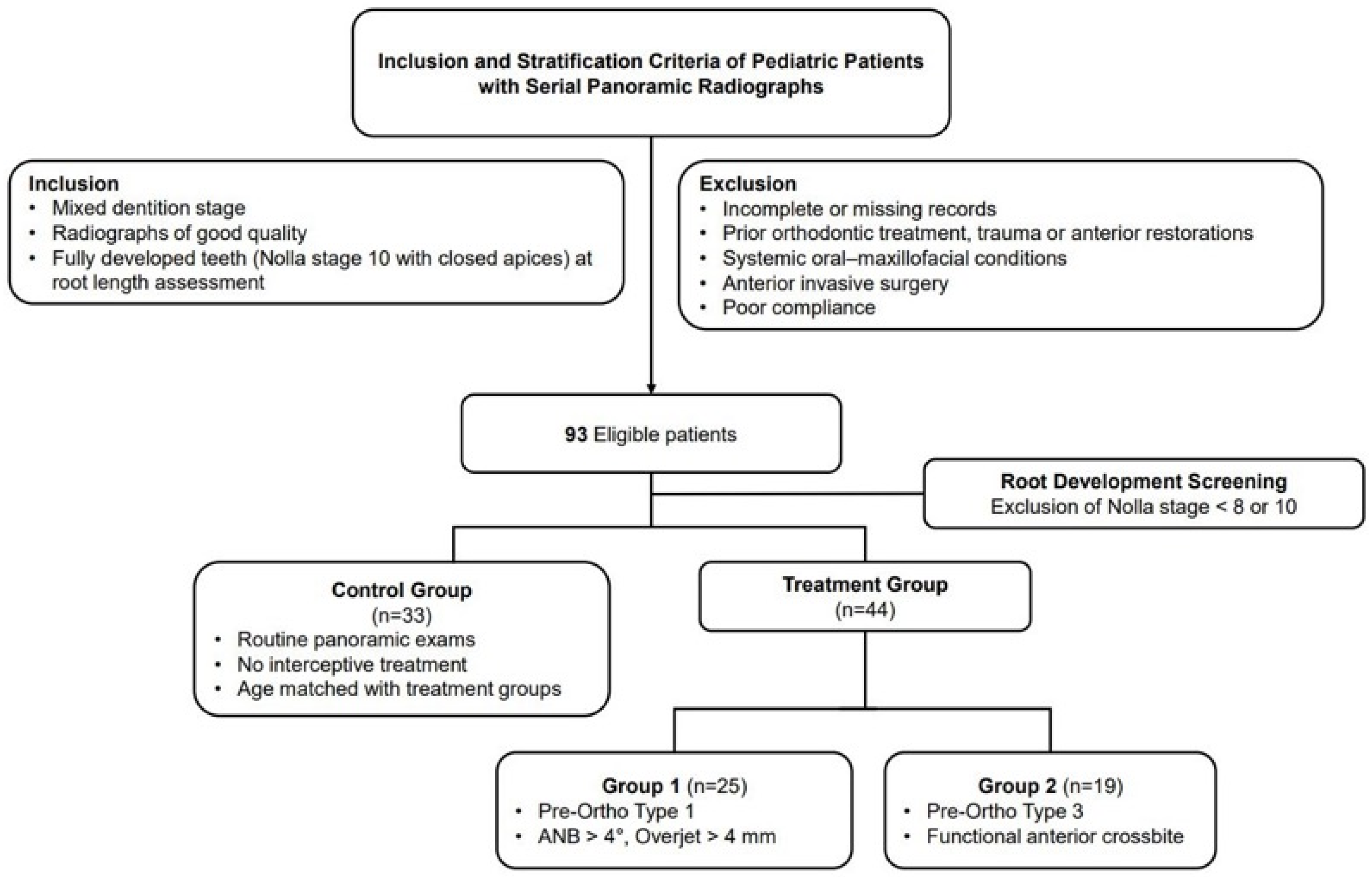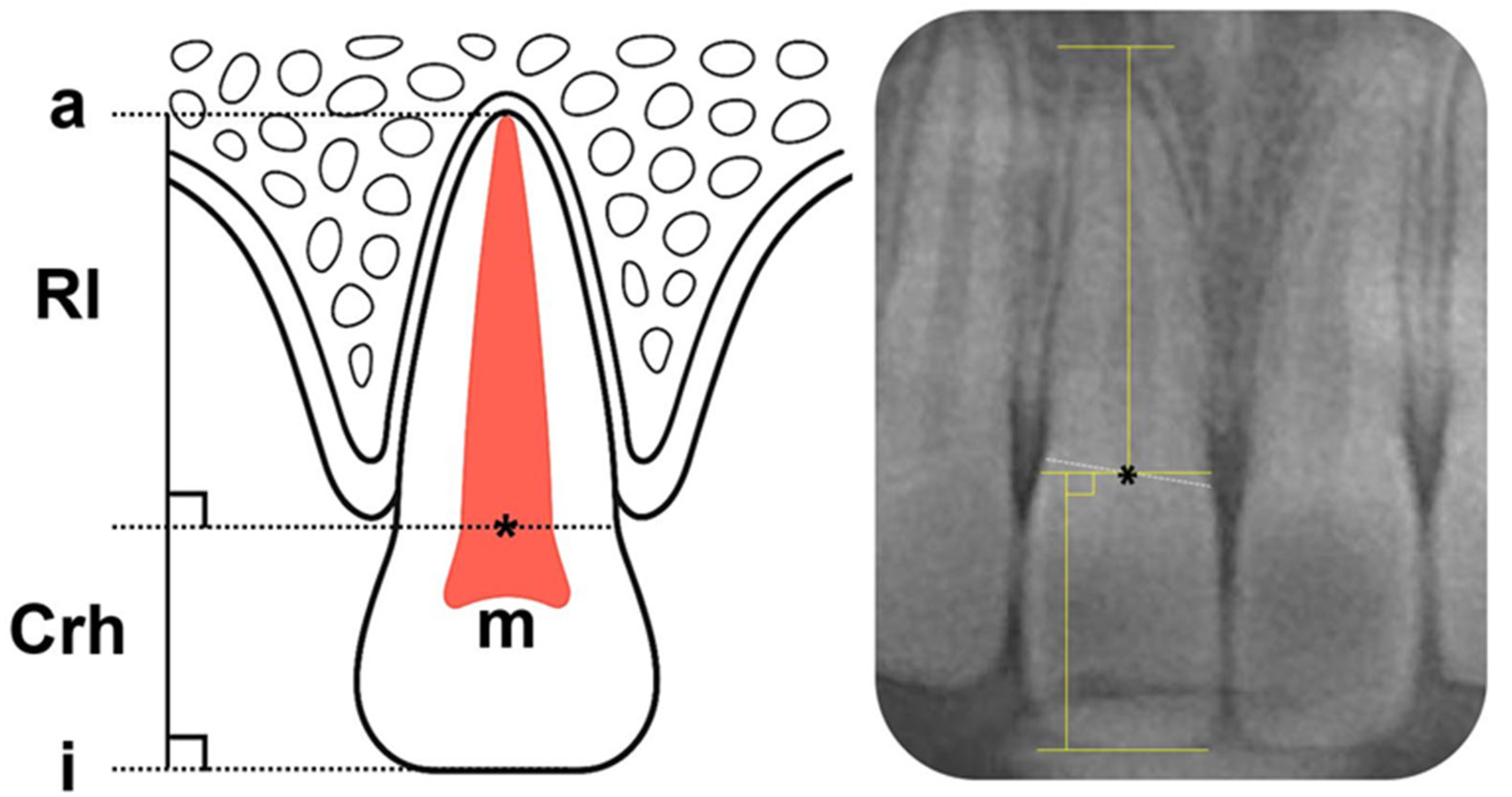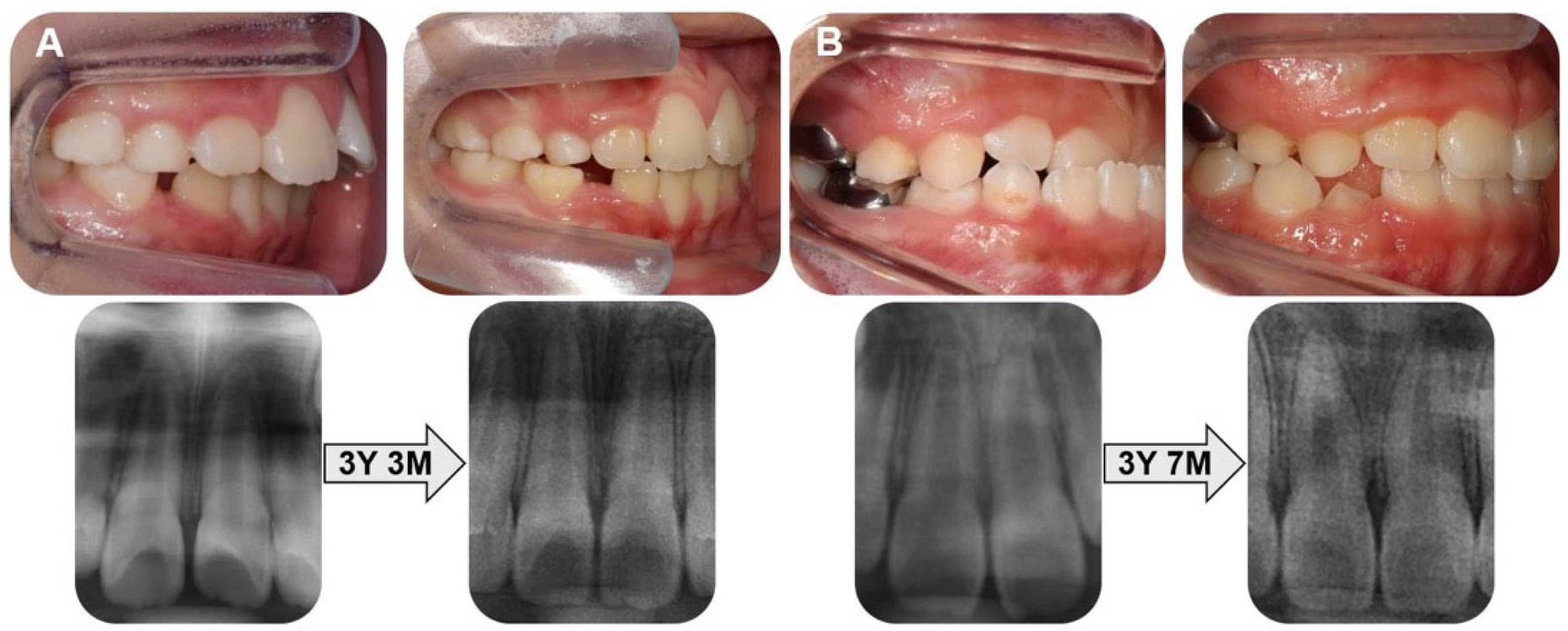Panoramic Assessment of Root Development in Immature Maxillary Incisors After Treatment with Prefabricated Functional Appliances
Abstract
Highlights
- Final root length and root-to-crown ratio showed no significant differences between the PFA-treated and control groups.
- Neither initial root stage (Nolla 8 or 9) nor appliance wear duration influenced the maturation of immature roots.
- Early PFA treatment appears safe for mixed-dentition children, as it does not affect the normal development of immature roots.
- PFAs may be suitable for correcting skeletal Class II and functional anterior crossbite when root growth is regularly monitored.
Abstract
1. Introduction
2. Materials and Methods
2.1. Study Design and Participants
2.2. Control Group
2.3. Treatment Group
2.4. Study Methods
2.5. Statistical Analysis
3. Results
4. Discussion
Author Contributions
Funding
Institutional Review Board Statement
Informed Consent Statement
Data Availability Statement
Conflicts of Interest
Abbreviations
| ANB | A point–Nasion–B point angle |
| ALARA | As low as reasonably achievable |
| CEJ | Cemento-enamel junction |
| CBCT | Cone-beam computed tomography |
| ICC | Intraclass correlation coefficient |
| OIEARR | Orthodontically induced external apical root resorption |
| PFA | Prefabricated functional appliance |
| R/C ratio | Root-to-crown ratio |
| SD | Standard deviation |
References
- Garrocho-Rangel, A.; Hernandez-Garcia, G.; Yanez-Gonzalez, E.; Ruiz-Rodriguez, S.; Rosales-Berber, M.; Pozos-Guillen, A. 2 × 4 appliance in the mixed dentition stage: A scoping review of the evidence. J. Clin. Pediatr. Dent. 2023, 47, 1–8. [Google Scholar] [CrossRef]
- Koaban, A.; Al-Harbi, S.K.; Al-Shehri, A.Z.; Al-Shamri, B.S.; Aburazizah, M.F.; Al-Qahtani, G.H.; Al-Wusaybie, L.H.; Alkhalifa, L.B.; Al-Saad, M.M.; Al-Nehab, A.A.; et al. Current trends in pediatric orthodontics: A comprehensive review. Cureus 2024, 16, e68537. [Google Scholar] [CrossRef]
- Mohammed, H.; Cirgic, E.; Rizk, M.Z.; Vandevska-Radunovic, V. Effectiveness of prefabricated myofunctional appliances in the treatment of Class II division 1 malocclusion: A systematic review. Eur. J. Orthod. 2020, 42, 125–134. [Google Scholar] [CrossRef]
- Eslami, S.; Stuhlfelder, J.; Rhie, S.I.; Buhling, S.; Balut, M.G.; Nucci, L.; Jamilian, A.; Sayahpour, B. Does the phase-one functional therapy increase the risk of an external apical root resorption following the phase-two fixed orthodontic treatment? A pilot study. Dent. J. 2025, 13, 95. [Google Scholar] [CrossRef]
- Ronsivalle, V.; Quinzi, V.; La Rosa, S.; Leonardi, R.; Lo Giudice, A. Comparative analysis of skeletal changes, occlusal changes, and palatal morphology in children with mild Class III malocclusion treated with elastodontic appliances and bimaxillary plates. Children 2023, 10, 1219. [Google Scholar] [CrossRef]
- Currell, S.D.; Liaw, A.; Blackmore Grant, P.D.; Esterman, A.; Nimmo, A. Orthodontic mechanotherapies and their influence on external root resorption: A systematic review. Am. J. Orthod. Dentofac. Orthop. 2019, 155, 313–329. [Google Scholar] [CrossRef] [PubMed]
- Harsha, G.D.; Padma Priya, C.V.; Arunachalam, S.; Varma, D.K.; Chakravarthy, V.; Manda, A. Appraisal of root-crown ratio of maxillary incisors in various skeletal and dental malocclusions. J. Dr. YSR Univ. Health Sci. 2022, 11, 6–10. [Google Scholar] [CrossRef]
- Lin, J.; Zheng, Q.; Wu, Y.; Zhou, M.; Chen, J.; Wang, X.; Kang, T.; Zhang, W.; Chen, X. Quantitative analysis and clinical determinants of orthodontically induced root resorption using automated tooth segmentation from CBCT imaging. BMC Oral Health 2025, 25, 694. [Google Scholar] [CrossRef]
- Dodeja, T.; Alsulaiman, A.A.; Will, L.A.; Saade, M.; Motro, M. Orthodontic forces interrupt root formation in immature teeth: Myth or fact? A pilot study. Turk. J. Orthod. 2025, 38, 12–19. [Google Scholar] [CrossRef] [PubMed]
- Wasserman-Milhem, I.; Bravo-Casanova, M.L.; Caraballo-Moreno, F.A.; Granados-Pelayo, D.A.; Restrepo-Bolívar, C.P. Orthodontic tooth movement in immature apices: A systematic review. Rev. Fac. Odontol. Univ. Antioq. 2016, 27, 367–388. [Google Scholar] [CrossRef]
- Flores-Mir, C.; Rosenblatt, M.R.; Major, P.W.; Carey, J.P.; Heo, G. Measurement accuracy and reliability of tooth length on conventional and CBCT reconstructed panoramic radiographs. Dent. Press J. Orthod. 2014, 19, 45–53. [Google Scholar] [CrossRef]
- Jinrui, X.; Zihan, W.; Jing, N. Research progress of crown-root ratio in orthodontics. Front. Med. Sci. Res. 2023, 5, 86–91. [Google Scholar] [CrossRef]
- Futyma-Gabka, K.; Rozylo-Kalinowska, I.; Piskorz, M.; Bis, E.; Borek, W. Evaluation of root resorption in maxillary anterior teeth during orthodontic treatment with a fixed appliance based on panoramic radiographs. Pol. J. Radiol. 2022, 87, e545–e548. [Google Scholar] [CrossRef]
- American Academy of Pediatric Dentistry. Prescribing dental radiographs for infants, children, adolescents, and individuals with special health care needs. Pediatr. Dent. 2018, 40, 213. [Google Scholar]
- Stramotas, S.; Geenty, J.P.; Darendeliler, M.A.; Byloff, F.; Berger, J.; Petocz, P. The reliability of crown–root ratio, linear and angular measurements on panoramic radiographs. Clin. Orthod. Res. 2000, 3, 182–191. [Google Scholar] [CrossRef] [PubMed]
- Levin, A.S.; McNamara, J.A., Jr.; Franchi, L.; Baccetti, T.; Frankel, C. Short-term and long-term treatment outcomes with the FR-3 appliance of Frankel. Am. J. Orthod. Dentofac. Orthop. 2008, 134, 513–524. [Google Scholar] [CrossRef] [PubMed]
- Cirgic, E.; Kjellberg, H.; Hansen, K. Treatment of large overjet in Angle Class II: Division 1 malocclusion with Andresen activators versus prefabricated functional appliances-a multicenter, randomized, controlled trial. Eur. J. Orthod. 2016, 38, 516–524. [Google Scholar] [CrossRef]
- Adarsh, K.; Sharma, P.; Juneja, A. Accuracy and reliability of tooth length measurements on conventional and CBCT images: An in vitro comparative study. J. Orthod. Sci. 2018, 7, 17. [Google Scholar] [CrossRef] [PubMed]
- Haghanifar, S.; Moudi, E.; Abbasi, S.; Bijani, A.; Mir, A.P.B.; Ghasemi, N. Root-crown ratio in permanent dentition using panoramic radiography in a selected Iranian population. J. Dent. 2014, 15, 173. [Google Scholar]
- Wishney, M.; Darendeliler, M.A.; Dalci, O. Myofunctional therapy and prefabricated functional appliances: An overview of the history and evidence. Aust. Dent. J. 2019, 64, 135–144. [Google Scholar] [CrossRef]
- Zhou, C.; Duan, P.; He, H.; Song, J.; Hu, M.; Liu, Y.; Liu, Y.; Guo, J.; Jin, F.; Cao, Y.; et al. Expert consensus on pediatric orthodontic therapies of malocclusions in children. Int. J. Oral. Sci. 2024, 16, 32. [Google Scholar] [CrossRef]
- Kallunki, J.; Bondemark, L.; Paulsson-Björnsson, L. Outcomes of early Class II malocclusion treatment: A systematic review. Dent. Oral Health Cosmesis 2018, 3, 1–7. [Google Scholar] [CrossRef]
- Ngan, P.; Moon, W. Evolution of Class III treatment in orthodontics. Am. J. Orthod. Dentofac. Orthop. 2015, 148, 22–36. [Google Scholar] [CrossRef] [PubMed]
- Roscoe, M.G.; Meira, J.B.; Cattaneo, P.M. Association of orthodontic force system and root resorption: A systematic review. Am. J. Orthod. Dentofac. Orthop. 2015, 147, 610–626. [Google Scholar] [CrossRef] [PubMed]
- Topkara, A.; Karaman, A.I.; Kau, C.H. Apical root resorption caused by orthodontic forces: A brief review and a long-term observation. Eur. J. Dent. 2012, 6, 445–453. [Google Scholar] [CrossRef] [PubMed]
- Zhang, M.; Zhang, P.; Koh, J.T.; Oh, M.H.; Cho, J.H. Evaluation of aligners and root resorption: An overview of systematic reviews. J. Clin. Med. 2024, 13, 1950. [Google Scholar] [CrossRef]
- Wan, J.; Zhou, S.; Wang, J.; Zhang, R. Three-dimensional analysis of root changes after orthodontic treatment for patients at different stages of root development. Am. J. Orthod. Dentofac. Orthop. 2023, 163, 60–67. [Google Scholar] [CrossRef]
- Moorrees, C.F.; Fanning, E.A.; Hunt, E.E., Jr. Age variation of formation stages for ten permanent teeth. J. Dent. Res. 1963, 42, 1490–1502. [Google Scholar] [CrossRef]
- Shin, M.; Song, J.; Lee, J.; Choi, B.; Kim, S.; Lee, H. Evaluation of the developmental age of permanent teeth by the Nolla method. J. Korean Acad. Pediatr. Dent. 2016, 43, 1–7. [Google Scholar] [CrossRef]
- Linge, B.O.; Linge, L. Apical root resorption in upper anterior teeth. Eur. J. Orthod. 1983, 5, 173–183. [Google Scholar] [CrossRef]
- Jiang, R.P.; McDonald, J.P.; Fu, M.K. Root resorption before and after orthodontic treatment: A clinical study of contributory factors. Eur. J. Orthod. 2010, 32, 693–697. [Google Scholar] [CrossRef] [PubMed]
- Sameshima, G.T.; Asgarifar, K.O. Assessment of root resorption and root shape: Periapical vs panoramic films. Angle Orthod. 2001, 71, 185–189. Available online: https://meridian.allenpress.com/angle-orthodontist/article/71/3/185/56474 (accessed on 18 October 2025).
- Yun, H.J.; Jeong, J.S.; Pang, N.S.; Kwon, I.K.; Jung, B.Y. Radiographic assessment of clinical root-crown ratios of permanent teeth in a healthy Korean population. J. Adv. Prosthodont. 2014, 6, 171–176. [Google Scholar] [CrossRef]
- Hölttä, P.; Nyström, M.; Evälahti, M.; Alaluusua, S. Root–crown ratios of permanent teeth in a healthy Finnish population assessed from panoramic radiographs. Eur. J. Orthod. 2004, 26, 491–497. [Google Scholar] [CrossRef] [PubMed]
- van Doornik, S.P.; Pijnenburg, M.B.M.; Janssen, K.I.; Ren, Y.; Kuijpers-Jagtman, A.M. Evaluation of the use of a clinical practice guideline for external apical root resorption among orthodontists. Prog. Orthod. 2024, 25, 15. [Google Scholar] [CrossRef]
- Li, X.; Xu, J.; Yin, Y.; Liu, T.; Chang, L.; Tang, Z.; Chen, S. Association between root resorption and tooth development: A quantitative clinical study. Am. J. Orthod. Dentofac. Orthop. 2020, 157, 602–610. [Google Scholar] [CrossRef]
- Khan, M.K.; Pandiyan, R.; Rather, S.H. Adverse effects of two-by-four fixed orthodontic appliance in mixed dentition period: A systematic review. Indian J. Dent. Res. 2025, 36, 94–102. [Google Scholar] [CrossRef]
- Şeker, E.D.; Yağci, A.; Kurt Demirsoy, K.; Yüzüak, E.N. A radiographic comparison of the root length and area after Class II treatment with two different functional appliances. Bezmialem Sci. 2020, 8, 321–329. [Google Scholar] [CrossRef]
- Choi, S.H.; Kim, J.S.; Kim, C.S.; Yu, H.S.; Hwang, C.J. Cone-beam computed tomography for the assessment of root–crown ratios of the maxillary and mandibular incisors in a Korean population. Korean J. Orthod. 2017, 47, 39–49. [Google Scholar] [CrossRef]
- Kim, S.J.; Kim, H.; Song, J.S.; Shin, T.J.; Kim, Y.J.; Kim, J.W.; Jang, K.T.; Hyun, H.K. Root growth and apical foramen closure velocity of maxillary permanent central incisor in Korean children. J. Korean Acad. Pediatr. Dent. 2024, 51, 432–441. [Google Scholar] [CrossRef]
- Puleio, F.; Lo Giudice, G.; Bellocchio, A.M.; Boschetti, C.E.; Lo Giudice, R. Clinical, Research, and Educational Applications of ChatGPT in Dentistry: A Narrative Review. Appl. Sci. 2024, 14, 10802. [Google Scholar] [CrossRef]




| Variable | Total (n = 77) | Control (n = 33) | Group 1 (n = 25) | Group 2 (n = 19) | p Value |
|---|---|---|---|---|---|
| Chronological age (yr) | 11.17 ± 0.85 | 11.38 ± 0.91 | 11.03 ± 0.78 | 10.98 ± 0.76 | 0.163 |
| Sex | 0.838 | ||||
| Male | 38 (49.4%) | 15 (45.5%) | 13 (52.0%) | 10 (52.6%) | |
| Female | 39 (50.6%) | 18 (54.5%) | 12 (48.0%) | 9 (47.4%) | |
| Initial age (yr) | 8.82 ± 1.23 | 8.44 ± 1.07 | |||
| Wear time (yr) | 2.08 ± 0.81 | 1.91 ± 0.74 | |||
| Nolla stage | |||||
| 8 | 22 (50.0%) | 11 (44.0%) | 11 (57.9%) | ||
| 9 | 22 (50.0%) | 14 (56.0%) | 8 (42.1%) | ||
| Variable | Control | Group 1 | Group 2 | p Value | |||
|---|---|---|---|---|---|---|---|
| Rt Lt | Mean | Rt Lt | Mean | Rt Lt | Mean | ||
| Crown height (mm) | 8.76 ± 0.63 8.80 ± 0.54 | 8.78 ± 0.56 | 9.04 ± 0.59 9.06 ± 0.47 | 9.05 ± 0.17 | 8.83 ± 0.71 9.01 ± 0.63 | 8.92 ± 0.12 | 0.087 † |
| Root length (mm) | 14.16 ± 1.46 14.07 ± 1.53 | 14.11 ± 1.40 | 14.52 ± 1.68 14.40 ± 1.26 | 14.46 ± 1.42 | 14.04 ± 1.18 13.75 ± 1.04 | 13.89 ± 1.04 | 0.201 † |
| Root–crown ratio | 1.63 ± 0.22 1.60 ± 0.21 | 1.62 ± 0.20 | 1.61 ± 0.21 1.59 ± 0.17 | 1.60 ± 0.18 | 1.59 ± 0.14 1.53 ± 0.12 | 1.56 ± 0.12 | 0.580 † |
| Nolla | Group 1 | p Value | Group 2 | p Value | |||
|---|---|---|---|---|---|---|---|
| Stage 8 | Stage 9 | Stage 8 | Stage 9 | ||||
| Crown height (mm) | Rt | 8.95 ± 0.46 | 9.12 ± 0.68 | 0.603 † | 8.94 ± 0.85 | 8.69 ± 0.49 | 0.480 |
| Lt | 9.15 ± 0.42 | 8.99 ± 0.51 | 0.400 | 9.05 ± 0.73 | 8.96 ± 0.51 | 0.749 | |
| Mean | 9.05 ± 0.41 | 9.05 ± 0.54 | 0.996 | 8.99 ± 0.56 | 8.82 ± 0.35 | 0.556 | |
| Root length (mm) | Rt | 14.84 ± 1.83 | 14.26 ± 1.57 | 0.420 | 13.97 ± 1.39 | 14.12 ± 0.89 | 0.780 |
| Lt | 14.64 ± 1.58 | 14.21 ± 0.95 | 0.441 | 13.82 ± 1.23 | 13.64 ± 0.78 | 0.702 | |
| Mean | 14.74 ± 1.21 | 14.23 ± 0.92 | 0.413 | 13.90 ± 0.93 | 13.88 ± 0.81 | 0.974 | |
| Root–crown ratio | Rt | 1.66 ± 0.19 | 1.57 ± 0.22 | 0.327 | 1.57 ± 0.18 | 1.62 ± 0.06 | 0.369 |
| Lt | 1.61 ± 0.20 | 1.59 ± 0.15 | 0.794 | 1.53 ± 0.15 | 1.53 ± 0.09 | 0.932 | |
| Mean | 1.63 ± 0.19 | 1.58 ± 0.18 | 0.499 | 1.55 ± 0.15 | 1.58 ± 0.06 | 0.621 | |
| Variable | Control | Group 1 | Group 2 | |||
|---|---|---|---|---|---|---|
| Rt | Lt | Rt | Lt | Rt | Lt | |
| Crown height (mm) | ||||||
| Male | 8.91 ± 0.63 | 8.95 ± 0.51 | 9.06 ± 0.57 | 9.13 ± 0.51 | 9.13 ± 0.72 | 9.37 ± 0.49 |
| Female | 8.63 ± 0.62 | 8.68 ± 0.55 | 9.13 ± 0.50 | 8.98 ± 0.42 | 8.50 ± 0.53 | 8.62 ± 0.51 |
| p value | 0.218 † | 0.165 † | 0.882 | 0.429 | 0.002 * | 0.001 * |
| Root length (mm) | ||||||
| Male | 14.55 ± 1.14 | 14.32 ± 1.39 | 14.47 ± 1.53 | 14.16 ± 0.88 | 14.18 ± 1.10 | 13.76 ± 0.92 |
| Female | 13.83 ± 1.65 | 13.86 ± 1.65 | 14.56 ± 1.87 | 14.67 ± 1.56 | 13.87 ± 1.30 | 13.73 ± 1.21 |
| p value | 0.151 † | 0.853 † | 0.897 | 0.335 † | 0.586 | 0.950 † |
| Root–crown ratio | ||||||
| Male | 1.65 ± 0.22 | 1.61 ± 0.21 | 1.60 ± 0.16 | 1.55 ± 0.11 | 1.56 ± 0.14 | 1.47 ± 0.07 |
| Female | 1.61 ± 0.22 | 1.60 ± 0.22 | 1.62 ± 0.26 | 1.64 ± 0.21 | 1.63 ± 0.15 | 1.59 ± 0.14 |
| p value | 0.528 † | 0.902 † | 0.762 | 0.145 | 0.276 | 0.002 * |
Disclaimer/Publisher’s Note: The statements, opinions and data contained in all publications are solely those of the individual author(s) and contributor(s) and not of MDPI and/or the editor(s). MDPI and/or the editor(s) disclaim responsibility for any injury to people or property resulting from any ideas, methods, instructions or products referred to in the content. |
© 2025 by the authors. Licensee MDPI, Basel, Switzerland. This article is an open access article distributed under the terms and conditions of the Creative Commons Attribution (CC BY) license (https://creativecommons.org/licenses/by/4.0/).
Share and Cite
Seo, W.; Park, S.; Lee, E.; Jeong, T.; Shin, J. Panoramic Assessment of Root Development in Immature Maxillary Incisors After Treatment with Prefabricated Functional Appliances. Children 2025, 12, 1416. https://doi.org/10.3390/children12101416
Seo W, Park S, Lee E, Jeong T, Shin J. Panoramic Assessment of Root Development in Immature Maxillary Incisors After Treatment with Prefabricated Functional Appliances. Children. 2025; 12(10):1416. https://doi.org/10.3390/children12101416
Chicago/Turabian StyleSeo, Wonbin, Soyoung Park, Eungyung Lee, Taesung Jeong, and Jonghyun Shin. 2025. "Panoramic Assessment of Root Development in Immature Maxillary Incisors After Treatment with Prefabricated Functional Appliances" Children 12, no. 10: 1416. https://doi.org/10.3390/children12101416
APA StyleSeo, W., Park, S., Lee, E., Jeong, T., & Shin, J. (2025). Panoramic Assessment of Root Development in Immature Maxillary Incisors After Treatment with Prefabricated Functional Appliances. Children, 12(10), 1416. https://doi.org/10.3390/children12101416








